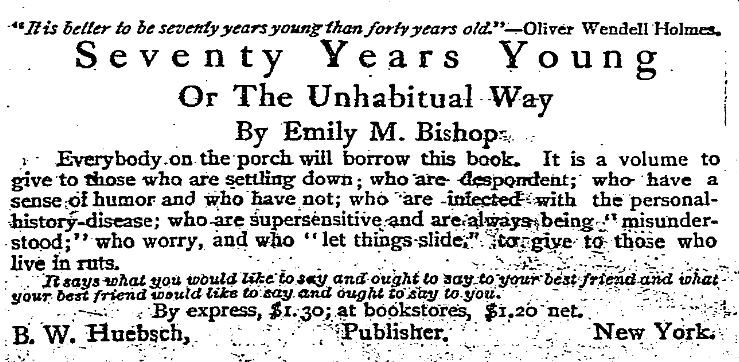As you might imagine, I read a lot of books on aging. In general, the authors fall into two large camps. The pessimists contend that aging is a process of limitations; gradually we lose skills and eventually we die. The optimists argue that much of aging is in our minds; if we keep a good attitude, we can run marathons until we are one hundred. My generation, the never-say-die boomers, tends to take an optimistic view. But we didn’t invent this approach, as shown in this very optimistic volume on aging published in 1907.
The thesis of this book is that habits cause aging, and thus everyone should try to inject elements of surprise and adventure into daily life. It is possible to be old acting and stuck in your ways at forty; likewise, it is possible to be active and lively at seventy. What makes the difference, Bishop claims, is your approach to life. A seventy-years-young-person will find a new hobby, join a new club, and see new places. “Keep out of ruts—ruts of thinking, feeling, talking, acting, living! That is the physiological and psychological recipe for prolonged youngness.” (73)
Ever consistent, Bishop extends her ideas to the world of fashion as well. Dressing according to proper standards “results in the sacrifice of individuality, of simple sincerity of expression and of youthfulness,” she claims. (97) Older women should throw off their black dresses and wear more color. If they have the means, they should get rid of shabby old outfits and try a new style. Sound familiar? As a fashion adviser, Bishop was definitely ahead of her time (and maybe current writers are riffling through old books.)
My search for a photograph of Emily M. Bishop came up empty, but it wasn’t hard to find out about her life. Born in 1858, she wasn’t anywhere never seventy when she wrote this popular book, which went through numerous reprintings. (It is available from many sources on line.) Bishop was a Delsarte teacher, a system of gestures and movement that was a precursor of modern dance. She lectured about movement, health, and aging on the Chautauqua circuit, an adult education project in late nineteenth and early twentieth century America. In addition, she penned home economics pamphlets and was part of the women’s suffrage movement.
Emily Bishop died in 1916, not quite making it to seventy. I wondered what she was wearing in the last decades of her life.



Yes, I should throw off my black and wear more color…(except black tights and leotards for my Delsart classes). It was all pretty radical advice for that era, don’t you think? Though the Arts and Crafts movement was the precursor to folkies, hippies and hipsters.
what a thoughtful piece…. there was a facebook/newspaper post here last week comparing the queen of england to the spanish royal family in style stakes – slow news day obviously ( http://www.independent.ie/style/celebrity/celebrity-news/spanish-royal-family-triumphs-over-the-queen-and-princess-beatrice-in-the-easter-style-stakes-31119559.html) – and the jist of the article was the spanish royal family looked demure and cool whereas the english royals looked overdressed. the facebook majority view was similar to my own in that the queen looked stunning in blue and totally embracing the spring unlike the dowdy look of the others (and how amazing the queen looks for here age). the most inspiring people for me now are the ones that will keep on keeping on, and with the ‘best side out’. (this includes the 95yr old man that ran 200m in less than a minute a month ago….)
I really hate that she died before reaching seventy. Any idea of what caused her death?
Interesting, this looks like a good book to track down and read.
I wonder how she defines personal-history disease? Someone whose only topic is themselves? I’ve always said that a sure of being old (regardless of your chronological age) is when your topics of conversations are limited to
who is sick
who died
a detailed listing of your ailments
what you had for lunch